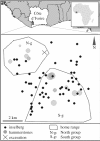Distance-decay effect in stone tool transport by wild chimpanzees
- PMID: 28003445
- PMCID: PMC5204162
- DOI: 10.1098/rspb.2016.1607
Distance-decay effect in stone tool transport by wild chimpanzees
Abstract
Stone tool transport leaves long-lasting behavioural evidence in the landscape. However, it remains unknown how large-scale patterns of stone distribution emerge through undirected, short-term transport behaviours. One of the longest studied groups of stone-tool-using primates are the chimpanzees of the Taï National Park in Ivory Coast, West Africa. Using hammerstones left behind at chimpanzee Panda nut-cracking sites, we tested for a distance-decay effect, in which the weight of material decreases with increasing distance from raw material sources. We found that this effect exists over a range of more than 2 km, despite the fact that observed, short-term tool transport does not appear to involve deliberate movements away from raw material sources. Tools from the millennia-old Noulo site in the Taï forest fit the same pattern. The fact that chimpanzees show both complex short-term behavioural planning, and yet produce a landscape-wide pattern over the long term, raises the question of whether similar processes operate within other stone-tool-using primates, including hominins. Where hominin landscapes have discrete material sources, a distance-decay effect, and increasing use of stone materials away from sources, the Taï chimpanzees provide a relevant analogy for understanding the formation of those landscapes.
Keywords: chimpanzees; distance-decay effect; primate archaeology; stone tools; transport.
© 2016 The Author(s).
Figures





Similar articles
-
Revisiting Panda 100, the first archaeological chimpanzee nut-cracking site.J Hum Evol. 2018 Nov;124:117-139. doi: 10.1016/j.jhevol.2018.04.016. Epub 2018 Sep 18. J Hum Evol. 2018. PMID: 30236627
-
Chaînes opératoires and resource-exploitation strategies in chimpanzee (Pan troglodytes) nut cracking.J Hum Evol. 2008 Jul;55(1):148-63. doi: 10.1016/j.jhevol.2008.02.005. Epub 2008 Mar 24. J Hum Evol. 2008. PMID: 18359504
-
Searching for the earliest archaeological record: insights from chimpanzee material landscapes.J R Soc Interface. 2024 Aug;21(217):20240101. doi: 10.1098/rsif.2024.0101. Epub 2024 Aug 21. J R Soc Interface. 2024. PMID: 39163030 Free PMC article.
-
On the tool use behavior of the bonobo-chimpanzee last common ancestor, and the origins of hominine stone tool use.Am J Primatol. 2014 Oct;76(10):910-8. doi: 10.1002/ajp.22284. Epub 2014 Apr 7. Am J Primatol. 2014. PMID: 24710771 Review.
-
Primate archaeology evolves.Nat Ecol Evol. 2017 Oct;1(10):1431-1437. doi: 10.1038/s41559-017-0286-4. Epub 2017 Sep 21. Nat Ecol Evol. 2017. PMID: 29185525 Review.
Cited by
-
Modeling a primate technological niche.Sci Rep. 2021 Nov 30;11(1):23139. doi: 10.1038/s41598-021-01849-4. Sci Rep. 2021. PMID: 34848740 Free PMC article.
-
Planning abilities of wild chimpanzees (Pan troglodytes troglodytes) in tool-using contexts.Primates. 2024 Nov;65(6):525-539. doi: 10.1007/s10329-023-01106-4. Epub 2023 Dec 16. Primates. 2024. PMID: 38103142 Free PMC article.
-
New Caledonian crows keep 'valuable' hooked tools safer than basic non-hooked tools.Elife. 2021 Dec 21;10:e64829. doi: 10.7554/eLife.64829. Elife. 2021. PMID: 34930523 Free PMC article.
-
Tool skill impacts the archaeological evidence across technological primates.Sci Rep. 2024 Jul 17;14(1):16556. doi: 10.1038/s41598-024-67048-z. Sci Rep. 2024. PMID: 39019910 Free PMC article.
-
Group-specific archaeological signatures of stone tool use in wild macaques.Elife. 2019 Oct 22;8:e46961. doi: 10.7554/eLife.46961. Elife. 2019. PMID: 31635691 Free PMC article.
References
-
- Furuichi T, Sanz C, Koops K, Sakamaki T, Ryu H, Tokuyama N, Morgan D. 2015. Why do wild bonobos not use tools like chimpanzees do? Behaviour 152, 425–460. (10.1163/1568539X-00003226) - DOI
-
- Boesch C, Boesch H. 1984. Mental map in wild chimpanzees: an analysis of hammer transports for nut cracking. Primates 25, 160–170. (10.1007/BF02382388) - DOI
MeSH terms
Associated data
LinkOut - more resources
Full Text Sources
Other Literature Sources

